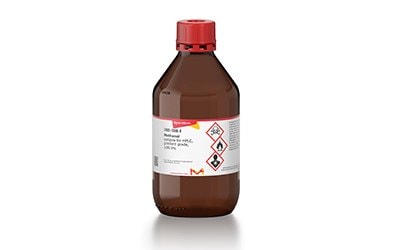Methanol
Products
Methanol is a polar organic solvent, also known as methyl alcohol. It is a transparent liquid with chemical formula CH3OH. The electronegativity difference between the atoms of the -OH group generates a negative region, and this influences the carbon and hydrogens region making it positive. Methanol is being considered as a potential hydrogen source in fuel cell technology due to its high H/C ratio, low propensity for soot generation, relatively low reforming temperature and its liquid state at room temperature.
At industrial scale, methanol is produced using natural gas as the principal feedstock. The olefins (ethylene or propylene) formed from methanol via MTO (methanol-to-olefins) process can be an alternative to oil and gas for the production of hydrocarbon fuels.
Methanol is used as a solvent in recrystallization and for extraction and purification of compounds in chromatography.
Methanol: solubility in organic solvents
Methanol is soluble in many organic solvents, including ethers, alcohols, ketones, and chlorinated hydrocarbons. Its solubility depends on the polarity and molecular structure of the solvent, as well as the temperature and pressure. In nonpolar solvents such as benzene, toluene, and hexane, methanol is only slightly soluble. In polar solvents such as ethanol, propanol, and acetone, methanol is highly soluble.
Methaol with boron trifluoride is used as reagent or catalyst in organic synthetic reactions, generally for esterification of carboxylic acids.
HPLC (high-performance liquid chromatography) grade methanol
Methanol is commonly used as a mobile phase component in HPLC and due to its low boiling point, high solubility with a variety of compounds, and low toxicity. It is often used in reverse-phase HPLC to separate polar compounds such as amino acids and peptides, and in normal-phase HPLC to separate non-polar compounds.
In HPLC, methanol is often combined with other solvents, such as water or acetonitrile, to create a binary or ternary mobile phase. The composition of the mobile phase can be adjusted to optimize the separation of the sample components.
LC-MS (liquid chromatography-mass spectrometry) grade methanol
LC-MS grade methanol typically has a minimum purity of 99.9% and is free of impurities such as heavy metals, salts, and other organic contaminants that can negatively impact the LC-MS analysis. High-purity solvents are used in LC-MS to avoid contamination and interference with the analysis.
Stable isotopes of methanol as analytical/reference standards
Deuterated methanol like methanol-d4 is a form of methanol, where the hydrogen atoms have been replaced with deuterium. This is used as an internal standard in spectroscopic applications, such as nuclear magnetic resonance (NMR) spectroscopy and mass spectrometry (MS).
In HPLC, deuterated methanol can also be used as a reference compound in quantitative analysis. As its retention time is well-known and stable, it helps to correct the instrument variability and ensures accurate quantitation of the analytes in the sample.
Oxygen isotopes of methanol (Methanol-18O, 17O) and carbon isotopes of methanol (Methanol-13C) are used in a variety of scientific applications, such as to study isotope geochemistry, environmental studies, and metabolic research.
To continue reading please sign in or create an account.
Don't Have An Account?